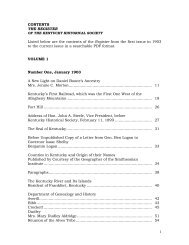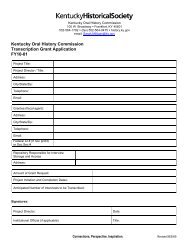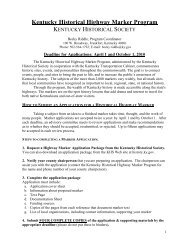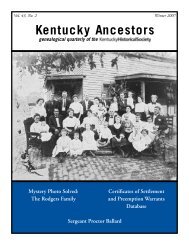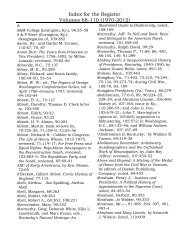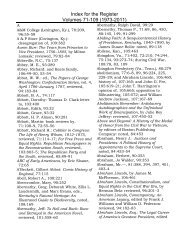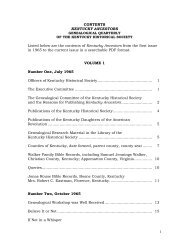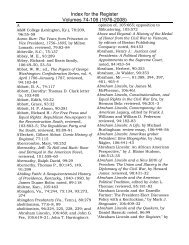Kentucky Ancestors, Volume 46, Number 2 - Kentucky Historical ...
Kentucky Ancestors, Volume 46, Number 2 - Kentucky Historical ...
Kentucky Ancestors, Volume 46, Number 2 - Kentucky Historical ...
Create successful ePaper yourself
Turn your PDF publications into a flip-book with our unique Google optimized e-Paper software.
to the clerk of the county court as delinquent.” The<br />
county court certified to the state auditor the amount<br />
due the assessor for his services after the tax book<br />
was completed and returned. Assessors and their<br />
assistants had to swear in open court that all persons<br />
listing taxable property had “made oath to the truth<br />
of the schedule.” The assessor received ten cents for<br />
each list of taxable estate; payment for services was<br />
made by the state treasurer upon the warrant of the<br />
state auditor.<br />
All estate taxed according to its value was ordered<br />
to be valued in gold and silver, as of the tenth day<br />
of January preceding. “And the person owning or<br />
possessing the same on that day was directed to list<br />
the estate with the assessor and remain bound for the<br />
tax, notwithstanding he may have sold or parted with<br />
the same.”<br />
Merchants and grocers were ordered to list the<br />
goods and groceries on hand on the tenth day of<br />
April in each year. They stated, under oath, the full<br />
value thereof, exclusive of the articles manufactured<br />
by <strong>Kentucky</strong> families.<br />
Assessors, from their own knowledge and from<br />
the statements of the person listing the property for<br />
taxation, and such other evidence as they obtained<br />
upon oath of witnesses, fixed a full and fair value<br />
upon all the estate listed for taxation, which was to<br />
be taxed according to its value, then entered the same<br />
in the order and manner prescribed, in the tax book,<br />
giving the aggregate value.<br />
Pursuant to legislation approved 17 February<br />
1851, tax assessors were directed to record the names<br />
of “deaf and dumb children between the ages of seven<br />
and twenty-one years, inclusive” and the name of the<br />
post office nearest their residence on the back page<br />
(or cover) of tax assessment books.<br />
The tax assessor was required to list the names<br />
of tavern keepers and the owners or keepers of stud<br />
horses, jacks and bulls who had obtained a license in<br />
the assessment book returned to the auditor.<br />
In 1857 and every eighth year thereafter, the<br />
assessors’ book had to include a statement of the<br />
number of qualified voters residing in the county<br />
and, when a town or city within his county had<br />
separate representation in either house of the general<br />
assembly, the assessor had to report the number of<br />
qualified voters in the city or town.<br />
The assessor, at the time he returned his tax book,<br />
was also ordered to return the names of all delinquent<br />
78 | <strong>Kentucky</strong> <strong>Ancestors</strong><br />
and fraudulent taxpayers. The clerk was directed to<br />
issue a summons stating the offense in general terms,<br />
against each of the delinquents, returnable to the<br />
next term of the county court. The defendant had<br />
the right to have his case heard by a jury “composed<br />
of bystanders summoned by the sheriff.” If the<br />
defendant was found guilty, the court was ordered<br />
to enter the judgment for the fine, and triple tax and<br />
costs. The fine and tax was to be certified by the clerk<br />
to the state auditor and accounted for by the sheriff as<br />
other public moneys.<br />
The sheriff, by virtue of his office, collected tax<br />
revenue from and after the first of June each year.<br />
The sheriff accounted for and paid all taxes and other<br />
public moneys, for which he was bound, into the<br />
state treasury by 15 December each year. The sheriff<br />
also reported the names of insolvent and delinquent<br />
taxpayers then proceeded to sell properties to recover<br />
tax revenues. The sheriff was paid twenty-five cents<br />
for each list of taxable property that he reported and<br />
which the assessor failed to report.<br />
Each county judge appointed “three discreet<br />
taxpayers, citizens of the county” to serve on the<br />
board of supervisors to oversee tax collection. It<br />
was their duty to examine the tax books each year,<br />
to correct any errors of the assessor, and, in cases<br />
where they were of the opinion that the estate was<br />
incorrectly valued, to fix the same at its proper value.<br />
The county clerk, after examining and approving<br />
the tax books, was directed to make two copies<br />
thereof—one for the sheriff and the other for the<br />
state auditor. If the tax book for the year wasn’t<br />
returned by the assessor, the county clerk was ordered<br />
to copy and deliver to the sheriff the tax book of the<br />
previous year by the first day of June. The book was<br />
to be used for collection and payment of taxes due.<br />
The lands of nonresident proprietors were<br />
ordered to be listed with the auditor of public<br />
accounts for taxation purposes. “If not so entered,<br />
they shall be thereby forfeited, and the title vested in<br />
the Commonwealth.” Nonresidents who challenged<br />
the tax assessment could apply to the county court<br />
for a correction. Nonresident proprietors were to<br />
pay the taxes due on their lands on or before the<br />
tenth day of February in each year. If not paid,<br />
fifty percent was added to the amount for the first<br />
failure; for the second year, the tax was doubled; and<br />
if not paid for three consecutive years, the tax was<br />
to be increased one hundred percent for the third





